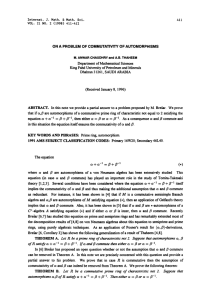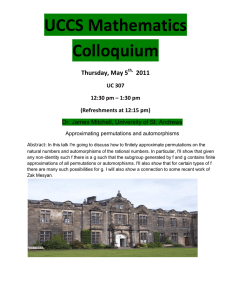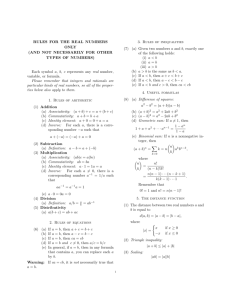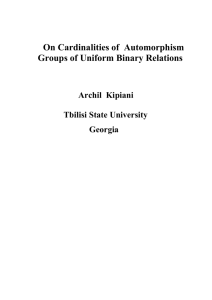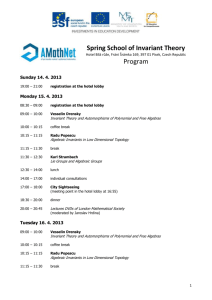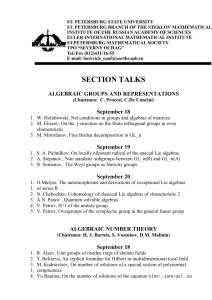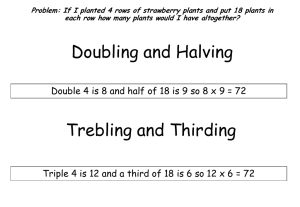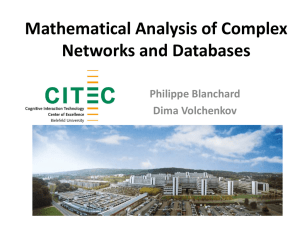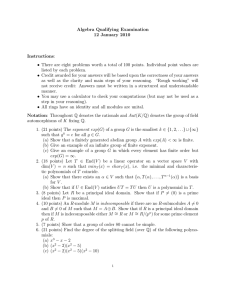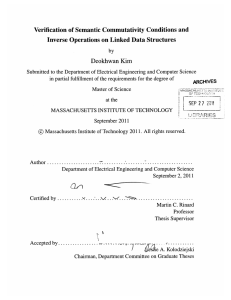Document 10457453
advertisement
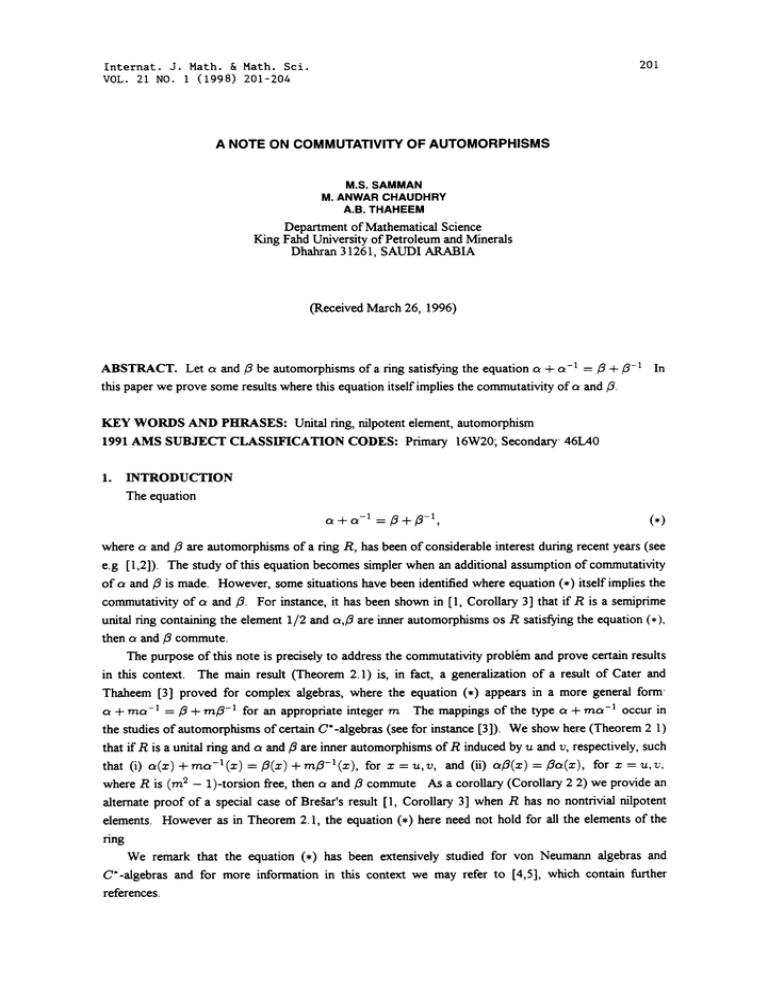
201 Internat. J. Math. & Math. Sci. (1998) 201-204 VOL. 21 NO. A NOTE ON COMMUTATIVITY OF AUTOMORPHISMS M.S. SAMMAN M. ANWAR CHAUDHRY A.B. THAHEEM Department of Mathematical Science King Fahd University of Petroleum and Minerals Dhahran 31261, SAUDI ARABIA (Received March 26, 1996) ABSTRACT. Let cz and /be automorphisms of a ring satisfying the equation c + c -1 -/ +/-1 In this paper we prove some results where this equation itself implies the commutativity of c and KEY WORDS AND PHRASES: Unital ring, nilpotent element, automorphism 1991 AMS SUBJECT CLASSIFICATION CODES: Primary 16W20; Secondary 46L40 INTRODUCTION The equation where c and are automorphisms of a ring R, has been of considerable interest during recent years (see e.g [1,2]). The study of this equation becomes simpler when an additional assumption of commutativity of a and is made. However, some situations have been identified where equation (,) itself implies the For instance, it has been shown in [1, Corollary 3] that if R is a semiprime commutativity of a and unital ring containing the element 1/2 and c, are inner automorphisms os R satisfying the equation (,), then a and commute. The purpose of this note is precisely to address the commutativity probl6m and prove certain results in this context. The main result (Theorem 2.1) is, in fact, a generalization of a result of Cater and Thaheem [3] proved for complex algebras, where the equation (,) appears in a more general form for an appropriate integer m The mappings of the type a + ma-1 occur in c + ma -1 + the studies of automorphisms of certain C’-algebras (see for instance [3]). We show here (Theorem 2 1) that if R is a unital ring and c and are inner automorphisms of R induced by u and v, respectively, such that (i) a(:r)+mc-l(z)= (:r)+m-l(z), for :r,=u,v, and (ii) a(z) a(z), for z=u,v, where R is (m 1)-torsion free, then a and commute As a corollary (Corollary 2 2) we provide an alternate proof of a special case of Brear’s result [1, Corollary 3] when R has no nontrivial nilpotent elements. However as in Theorem 2.1, the equation (,) here need not hold for all the elements of the . m-I ring We remark that the equation (,) has been extensively studied for yon Neumann algebras and C’-algebras and for more information in this context we may refer to [4,5], which contain further references. M S SAMMAN, M A CHAUDHRY AND A B THAHEEM 202 COMMUTATIVITY RESULTS We begin with the following theorem which generalizes a result of Cater and Thaheem [3 proved for complex algebras Our approach here is almost analogous to that of [3] THEOREM 2.1. Let R be a unital ring and a,/3 be inner automorphisms of R induced by u and v, respectively, such that 2. (Z) -b m/ -1 (z), for Ct() -[- mt -1 (Z) z u, v, (i) and for x (ii) u, v. If R is (m 1)-torsion free, then a and/3 commute. PROOF. Put k u-lv’av -1 We first show that k commutes with u and v Substituting x (ii), we get uzru -1 vuvu-lv -1 We may rewrite this equation as vu v in (1) uvk or It follows from (2) and (3) that kv Thus we can write (1) as (3) vk Thus k and v commute By symmetry, k and u also commute kuv Substituting z u-l’o,tz. z/,-l’o,lv-l"O ]"O (4) v’u. v in (i), we get uvtt -1 + rr’tt-lzrtt (1 + m)v. (5) (1 + m)vu. (6) Multiplying (5) on the right by u, we get uv + mu-lvuu It follows from (4) and (6) that uv + mkvu (1 + rn )’ou. (7) (1 + rn)kuv, (8) It follows from (4) and (7) that uv + mk2uv or what is the same (ink l)(k l)uv (rnk rnk k + 1)uv O. (9) Since uv is invertible, we get from (9) that rnk We observe from (4) that k-lvu v and k-1 in place of k, we get mk- k + 1 (10) 0. uv. Repeating the above procedure with v in place of u, u in place of (m -1 1)(-1 1) (11) 0. Multiplying (11) on the left by mk and on the fight by k, we obtain (rn ink)(1 k) m rnk -mk +mk O, (12) A NOTE ON COMMUTATIVITY OF AUTOMORPHISMS 203 or what is the same rnk + rak + rngk rn O. (13) Adding (10) and (13), we get (rn2- 1)(k- 1)= O. (14) Since R is (m 1)-torsion free, we get from (14) that k 1 0 or k 1 This implies uv vu and hence a and commute The following corollary gives an alternate proof of Bregar’s result 1, Corollary 3] in the special case when R has no nontrivial nilpotent elements with an additional assumption that (aB)(u) (3a)(u) and (aD)(v) (a)(v) However, in our setting it is sufficient for equation (,) to hold for some specific elements rather than all the elements of the ring to ensure the commutativity of a and B COROLLARY 2.2. Let R be a unital ring with no nonzero nilpotent elements and a, be inner automorphisms of R induced by u and v respectively such that a(’O) -1- O -1 (’O) (V) -[- -1 (’/3) (iii) and a(a:) a(x), for x u, v. (iv) Then a and 5 commute PROOF. As in the proof of Theorem 2 1, put k u-1UZt’V-1 Then k commutes with u and v follows from (iv) and consequently equation (4) holds Then using (iii) and following a procedure similar 0 Since R has no nonzero nilpotent elements, we get to Theorem 2 1, we obtain that (k- 1) k 1 0 or k 1. This proves that uv vu and hence a and commute REMARK 2.3. (a) We observe that the main argument in proving the commutativity of c and B has been to show that k 1. In fact, somewhat weaker condition, namely that k belongs to the center of R would also ensure the commutativity of a and 5 Therefore, it would also be interesting to prove that k is in the center of R 1. (b) It would be interesting to prove or disprove Theorem 2.1 for the case rn ACKNOWLEDGMENT. The authors gratefully acknowledge the support provided by King Fahd University of Petroleum and Minerals during this research. REFERENCES [I] [2] [3] [4] [5] BIAR, M, On certain pairs of automorphisms of rings, J. Austral. Math. Soc. (Series A), 54 (1993), 29-38. BREAR, M, On the composition of (, 5)-derivations of rings and applications to von Neumann algebras, Acta Sct. Math., 56 (1992), 369-375 CATER, F.S. and THAHEEM, A B., On a pair of automorphisms of C*-algebras, To appear in Ren. Sere. Mat. Univ. Padova. THAHEEM, A.B., On certain decompositional properties of von Neumarm algebras, Glasgow Math. J., 29 (1987), 177-179 THAHEEM, AB, On a functional equation on C*-algebras, Funkctal. Ekvac., 31 (1988), 411413.
